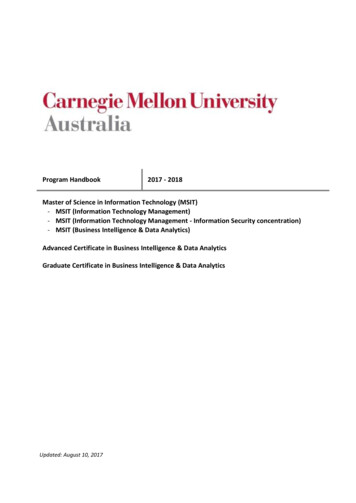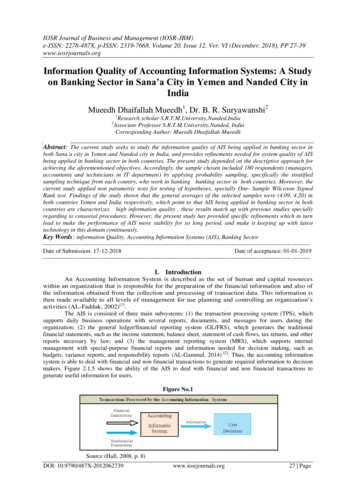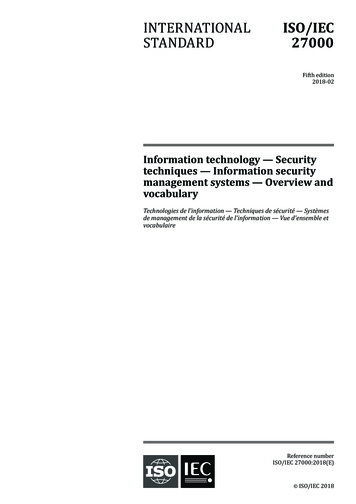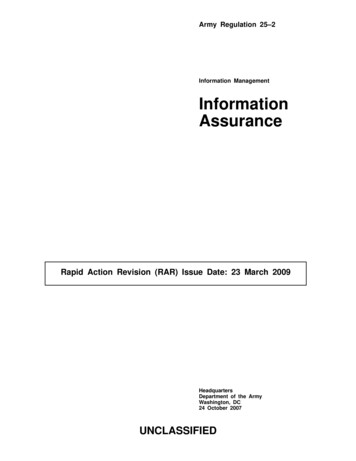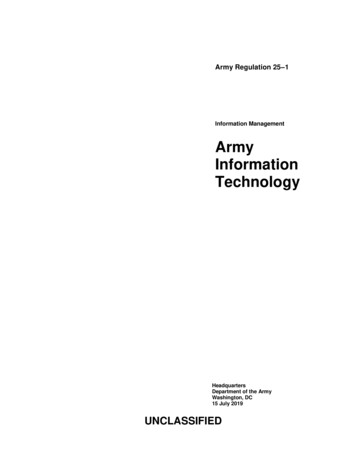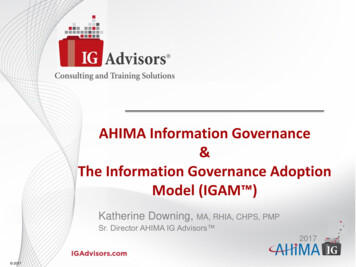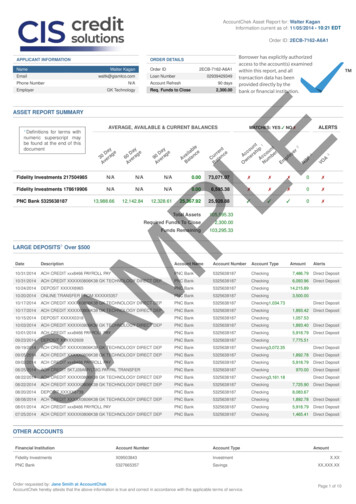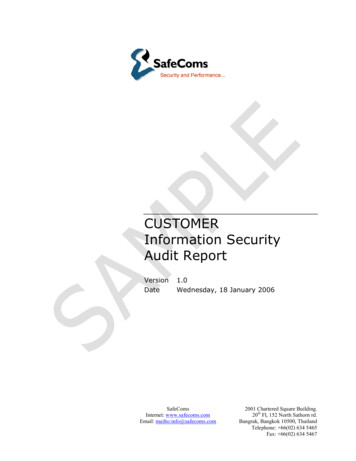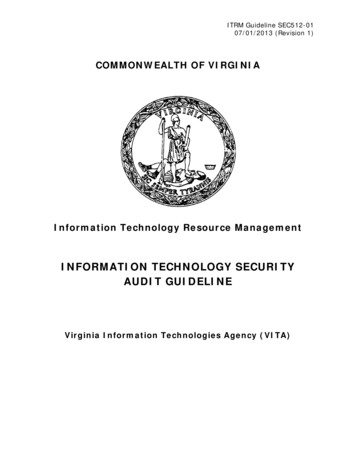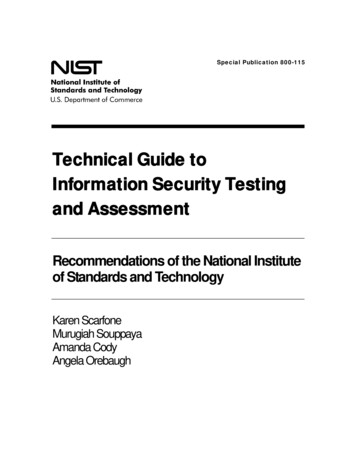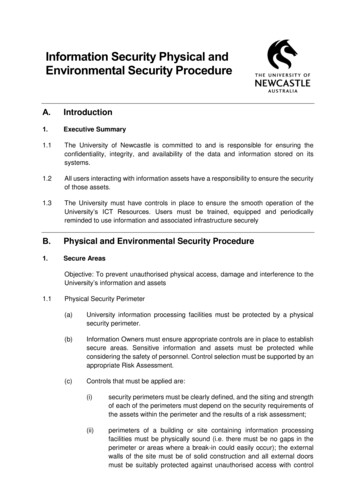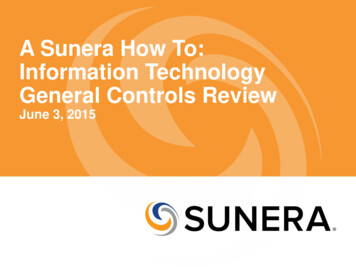
Transcription
A Sunera How To:Information TechnologyGeneral Controls ReviewJune 3, 2015
SpeakersSharon Gallo, Manager, CISA - sgallo@sunera.com More than 7 years of work experience providing audit and advisory services tolarge multinational and smaller Fortune 1000 clients in various industries.Expertise: Information Technology General Controls (ITGC) testing andremediation, SSAE 16 reports, application control testing, entity level testing,vendor assessments, and Software Development Lifecycle (SDLC) projects.Prior to Sunera, she was a Senior within Ernst & Young’s Information TechnologyRisk & Assurance practice.Cliff Stephens, Director - cstephens@sunera.com Expertise: Data analytics and CCM initiatives, implementing analytics tools, andleading teams on process improvement advisory, ITGC testing and remediation,application controls, and internal audit engagements.Prior to joining Sunera, he was a Senior Manager at Home Depot and wasresponsible for creating and leading the Internal Audit Data Analytics team.Built data analytics capabilities by implementing ACL Analytics Exchange,Tableau, SQL Server/Reporting Services, and Teratraining.2
Agenda Introductions SpeakersWhat is Sunera? Background Overview of standard ITGCsAudit Frameworks How to perform an ITGC standard review Practice Exercises Access to Programs and DataProgram Development and Change ManagementComputer OperationsQuestions
What is Sunera?Sunera is a business and technology risk management consulting firmdedicated to reducing technology risk, designing cost-saving solutions, andprotecting our clients’ customers and reputations.With a decade-long track record of delivering successful projects, we havethe experience and expertise to solve even the most complex technicalchallenges.Core ServicesData Privacy Internal Audit Information SecurityIT Audit Enterprise Risk Management Data AnalyticsTechnology Training SOX Compliance PCI4
National verHoustonLos AngelesMiamiNew YorkPhoenixRaleighSan FranciscoTampaTorontoVancouver5
BackgroundInformation TechnologyGeneral Controls (ITGCs)
Why are ITGCs important? Information Technology General Controls (ITGCs) can be defined as internalcontrols that assure the secure, stable, and reliable performance of computerhardware, software and IT personnel connected to financial systems. ITGCs affect the ability to rely on application controls and IT dependent manualcontrols. Without effective ITGCs, reliance cannot be placed on any application controls or ITdependent manual controls unless additional procedures are performed (e.g.,benchmarking). Even these additional procedures limit the ability to rely upon morethan one application control at a time. ITGCs are an integral part of many different operational and regulatory (federal andstate) audits, including:oooooIT operational reviewsHIPAA assessmentsSSAE16 assessmentsPCI reviews/auditsSOX assessments7
ITGC Areas of FocusThe following areas are typically addressed as part of ITGC: Access to Programs and Datao Controls that prevent inappropriate and unauthorized use of the system across all layers of systems,operating system, database and application.- Security Policy, Password, Unique IDs, Authorized Administrators, Users Access Provisioning,Users Access Reviews, Physical Security, Firewall, Monitoring (i.e. invalid logins, audit trails) Program Changeso Controls may involve required authorization of change requests, review of the changes, approvals,documentation, testing and assessment of changes on other IT components and implementation protocols.- Change Management Process for Regular and Emergency Changes (i.e. infrastructure andsoftware changes for all layers: O/S, database, application) Program Developmento Controls over development methodology, including system design and implementation, that outline specificphases, documentation requirements, change management, approvals and checkpoints to control thedevelopment or maintenance of the project.o Controls over the effective acquisition, implementation and maintenance of system software, databasemanagement, telecommunications software, security software, and utilities.- Software Development Life Cycle (SDLC) Computer Operationso Controls over the effective job configuration and scheduling, data center operations, data backup and datarecovery procedures.- Backups, Restorations, Job Scheduling8
ITGC Approach Across all LayersITGCs should be applied across all layers ofthe identified in-scope systems, including: Application Systemo Databaseo Collects and stores data supporting theapplication. Typically restricted to back-endusers.Operating Systemo Typically the system used by front-end usersto perform specific tasks (i.e., PeopleSoft).Supports the entire organization and serves asa back-bone to all systems (i.e., Windows).NetworkoA group of two or more computer systemslinked together that allows the exchange ofdata.9
Key Terms SOX – Sarbanes-Oxley Act of 2002. U.S. federal legislation that establishes new orenhanced requirements for financial reporting for all U.S. public company boards,management, and public accounting firms.PCAOB – Public Company Accounting Oversight Board. A private-sector, non-profitcorporation created by the Sarbanes-Oxley Act, to oversee the auditors of publiccompanies.COBIT – Control Objectives for Information and Related Technology. A comprehensiveframework for management of the governance of risk and control of IT, comprising 5domains, 37 IT processes and 210 control objectives. COBIT includes controls that addressall aspects of IT governance, but only those significant to financial reporting have been usedto develop this document.COSO – Committee of Sponsoring Organizations of the Treadway Commission. Aprivate-sector initiative, formed in 1985 to identify the factors that cause fraudulent financialreporting and to make recommendations to reduce its incidence. COSO has established acommon definition of internal controls, standards, and criteria against which companies andorganizations can assess their control systems.ISACA – Information Systems Audit and Control Association. International professionalorganization for information governance, control, security and audit professionals. Itsauditing and control standards are followed by practitioners worldwide.10
COSO vs. COBITThe most common framework used to evaluate ITGCs is the COBIT frameworkCOSOvs.COBIT Established to provide a genericframework for evaluating internal controls.SEC’s suggested Internal ControlsFramework for Sarbanes Oxley.Addresses application controls andgeneral IT controls at a high level.Does not dictate requirements for controlobjectives and related controls activity. Established by ISACA to be used for theIT component of documenting and testinginternal controls. Comprehensive framework for managingrisk and control for IT. More detailed and IT specific. Not a comprehensive Internal Controlsframework.How COBIT is used for evaluating ITGCs: Since ITGCs affect the entire organization, COBIT is mapped to COSO.15 COBIT IT processes are identified as being relevant for the IT component of internal controls.However, companies may add or remove other COBIT processes based on the specific situation.11
COBIT 4.1 Mapped to COSOThe Control Objectives for Information and relatedTechnology (COBIT) defines an IT governanceframework. COBIT4.1Control Environment – The control environmentsets the tone of an organization, influencing thecontrol consciousness of its people.Risk Assessment – Every entity faces a variety ofrisks from external and internal sources that mustbe identified and analyzed at both the entity andthe activity level.Control Activities – These policies andprocedures help ensure management directivesare carried out (e.g., preventive, detective, andmitigating controls).Information and Communication – Pertinentinformation must be identified, captured, andcommunicated in a manner and timeframe thatsupports all other control components.Monitoring – The monitoring process assessesthe quality of the system’s performance over timeby reviewing the output generated by controlactivities and conducting special evaluations.12
ITGC FrameworkCOBIT 5 OverviewCOBIT 5 The focus of COBIT 5 is on processes, that aresplit into governance and management areas.These two areas contain a total of 5 domains:Governance of Enterprise IToEvaluate, Direct and Monitor (EDM) – Providesdirection to information security and monitoring theoutcomeManagement of Enterprise IToAlign, Plan and Organize (APO) – Provides directionto solution delivery (BAI) and service delivery (DSS),oBuild, Acquire and Implement (BAI) – Provides thesolutions and passes them to be turned into services,oDeliver, Service and Support (DSS) – Receives thesolutions and makes them usable for end users, andoMonitor, Evaluate and Assess (MEA) – Monitors allprocesses to ensure that the direction provided isfollowed. Across these 5 domains, COBIT hasidentified 37 IT processes that aregenerally used by an organization as wellas specific practices.13
Mapping PCAOB AS 5 to COBIT 5Processes to Identify Relevant ITGC controls COBIT 5 processes mappedto PCAOB Auditing StandardNo. 5Identifies ITGCs that have adirect impact on the audit ofthe effectiveness of internalcontrols over financialreporting (SOX section 404)which can be used as abaseline for non-publicorganizations.14
How to Perform an ITGCStandard Review
Phase 1Phase 2Phase 3Our Approach for ITGC TestingPhase I Activities - IT Risk Assessment and Scoping IT Risk Assessmento Review and evaluate existing IT risk assessment documentation, if any.o Perform discovery sessions with key IT process/system owners to evaluate the current ITenvironment.o Evaluate any scheduled or pending IT projects that may impact the control environment.o Identify any relevant prior year audit feedback.o Perform IT risk assessment and map risks to ITGC framework (i.e., COBIT 5 objectives).Application Scopingo Identify the population of IT systems that are material (in-scope) for your particular auditthrough the IT risk assessment activities and documentation reviews.o Create/update an in-scope systems matrix that contains all in-scope systems attributes(software version, OS layers, database layers, authentication mechanism, etc.).ITGC Control Catalogo Identify relevant ITGC controls according to the IT environment and relevant to your type ofaudit.o Asses the control frequency and level of risk.o Design test procedures.16
Phase 1Phase 2Phase 3ITGC Catalog OverviewAn ITGC Catalog gives an organization and the auditors an overview of key controls.The catalog typically lists the Control Number, Control Objective, Frequency, Risks,and Control Description, and may also include prior noted deficiencies and whether ornot the control is manual/automated and preventive/detective.COBIT 5ProcessNameDSS 05ManageSecurityServicesCOBIT 5 ProcessDetailsCOBIT 5 Practice DetailsEnsure that all usersProtect enterprisehave information accessinformation to maintainrights in accordancethe level of informationwith their businesssecurity risk acceptablerequirements andto the enterprise incoordinate withaccordance with thebusiness units thatsecurity policy. Establishmanage their ownand maintain informationaccess rights withinsecurity roles and accessbusiness processes.privileges and performsecurity monitoring.RiskExpected ControlDescriptionKey / PreventativeControlNon- / Detective FrequencyCategoryControlsKeyManagementperiodically reviewsUnauthorized access user access rights toto resources,critical systemsprograms or dataincludingAccess tomay result in fraud,administrator, superProgramstheft, loss of data oruser and otherand Dataunauthorizedprivileged accounttransactions inaccess at all levelsfinancial systems.of the system(application, databaseand operating system).KeyDetectiveSemiannual17
Phase 1Phase 2Phase 3Our Approach for ITGC TestingPhase II Activities – Gather Audit Evidence Document Request List (“DRL”)o Identify evidence required for your audit and prepare a DRL.o Send the DRL to functional area managers to request evidence (such as ITManagers and Human Resource Manager).o Observe IT generate computer-generated reports, where possible. Captureinput parameters.o Obtain evidence and ensure that source data is accurate, complete and directlygenerated from the system, where possible.Population and Sample Selectiono Define your population.o Select samples that are representative of the population, according to thecontrol’s risk and frequency.o Reference AICPA AU Section 350 Audit Sampling guide.18
Phase 1Phase 2Phase 3Document Request ListA DRL is a list prepared by the auditor for items that will be required from theprocess and/or data owner prior to the commencement of fieldwork. Thisdocumentation is what is necessary for the testing of ITGC controls. The DRL mayinclude items such as policies/procedures, system documentation, user accesslists, audit logs and configurations.Request Type Control Ref#Key Control ActivitySystemRequested ItemsFor each AD production domain, please run the following script:Script 4 will extract the domain Password Policy, ScreensaverPolicy, and Audit Policy.PopulationDSS 05.02bPopulationPopulation1. Download and save "Script 4" from the link listed to the right(i.e. cell F17) to the desktop of the production server where theA standard password policy Windows Active domain controller is installed.Directoryhas been defined and critical2. Extract the “Windows Server - Domain Policies Script" to theapplications and supportingdesktop.platforms are configured3. Double click the “Windows Server - Domain Policies Script”according to the corporatefile.standard.4. Wait for the DOS command prompt windows to close.5. Provide a copy of the output files (i.e. WinDomainPolicies.vbs)Dynamics - App Screenshot of password configuration settings for thecorresponding system or configuration to show that the serverrelies on Active Directory for authentication (typically shown byHighJump - AppLDAP, web server or windows authentication settings).19
Phase 1Phase 2Phase 3Sample SelectionSamples are selected based on: Frequency of Control: Determined by the assumed population of controloccurrences per year and risk level. FrequencyPopulation Size(typical)Sample Size(typical)Annual11Quarterly42Monthly122 to 5Weekly525 to 10Daily25020 to 40Multiple Times per Day250 25 to 45Inherent Risk: The measure of auditor's assessment that the control willnot operate as intended (control failure).oooHighMediumLow20
Phase 1Phase 2Phase 3Sample Selection (continued)Statistical Sample Selection – Ensures that each member of the population has anequal chance of being selected. Random – Each item chosen from a population by a method involving an unpredictablecomponent. The sample is such that selected so that every possible sample has an equal chanceof being selected from the population.Computer – Software (such as ACL) is used to automate or simplify the audit processNon-Statistical Sample Section – The auditor may employ some bias when selectingthe sample. Haphazard – The auditor selects a sample from a population without following a structuredtechnique, however avoiding any conscious bias or predictability.Judgmental – The auditor intentionally places a bias on the sample (e.g., all sampling units over acertain value, all for a specific type of exception, all negatives, all new users, etc.) selected from apopulationNote: Population - the entire set of data from which a sample is selected and about which the ITAuditor wishes to draw conclusions.21
Phase 1Phase 2Phase 3Our Approach for ITGC TestingPhase III Activities – Perform testing procedures Testingo Prepare detailed test procedures for the key ITGC’s.o Perform the tests of design and evaluate the operating effectiveness of eachITGC.o Document test results and highlight any exceptions.o Confirm exceptions with stakeholders.o Provide IT Management and stakeholders feedback for future remediation ofidentified exceptions. Remediation Testingo Perform remediation testing.o Communicate results to all stakeholders.22
Phase 1Phase 2Phase 3Testing MethodsMethods for testing ITGCs:Testing MethodDefinitionThe auditor inquires (in writing or verbally) of the responsibleInquiryindividual as to what procedures are in place to address the controlbeing tested. This is typically the first step in each test.The auditor inspects the evidence provided to ensure that it isInspectionaccurate.The auditor inquires with one individual and corroborates the inquiryCorroborative Inquiryseparately with another individual.The auditor tests that automated controls within an IT application areoperating as expected. Examples of these kinds of controls may be:- That a predefined exception will be identified appropriately by thesystem (this exception may be associated with completeness and/orSystem Queryaccuracy of input, processing and output of the application)- That logical access configuration within the application are set in away that establishes segregation of duties and otherwise providesfor the authorization of transactions.23
Phase 1Phase 2Phase 3Test of Design vs. Test of EffectivenessTest of Design - Determines whether the controls, if operating properly, caneffectively prevent or detect errors or fraud that could result in materialmisstatements in the financial statements. Procedures the auditor performs to test and evaluate design effectivenessinclude inquiry, observation, and inspection of relevant documentation. Theprocedures the auditor performs to test and evaluate design effectiveness mightalso provide evidence that can be used to test the effectiveness of the control.Was the control designed appropriately?Test of Effectiveness – Involves evaluating whether internal control isoperating as designed. Procedures the auditor performs to test and evaluate test of operatingeffectiveness include inquiry, observation, and inspection of relevantdocumentation. Was the control consistently performed? Was the controlperformed by a person who had the necessary authority and qualifications toperform the control effectively?24
Phase 1Phase 2Phase 3Testing Methods (continued)Methods for testing ITGCs:Testing MethodObservationDefinitionThe auditor observes the responsible individualperforming a procedure.The auditor independently performs the steps asRe-Performance previously performed by a client or as detailed in aprocedure.KnowledgeAssessmentThe auditor combines inquiry, inspection and reperformance techniques to test the individuals’knowledge of a subject or competency to perform acontrol.25
Phase 1Phase 2Phase 3The Language Auditors SpeakAudit TermInquiryInspectionTest StepTest ResultsInquired with the IT Operations Manager, Joe Smith, onInquire of the IT Operations ManagerJanuary 18, 2015, and noted that PeopleSoft and Activeto gain an understanding of how userDirectory user IDs are administered by the IT Department. It isID’s are assigned to new users withinnoted that new users are assigned a unique ID based on theeach critical application.standard protocol of first initial and last name.Obtain and inspect the “Backup andRestore Policy” to determine if thepolicy clearly defines procedures inplace for restoring and testingbackups for critical systems.Obtained and inspected the “Backup and Restore Policy” fromthe company’s intranet on May 11, 2015, and noted that page 1of the policy details the procedures for restoration testing asfollows:“A structured test of the restore process will be performed toverify the quality and reliability of all backup tapes. All testdetails including the scope of the test, procedures and resultswill be documented in the ticketing system to maintain a recordof the testing history.”Note: Inquiry alone is never sufficient to provide a level o
COBIT 4.1 Mapped to COSO The Control Objectives for Information and related Technology (COBIT) defines an IT governance framework. Control Environment –The control environment sets the tone of an organization, influencing the control consciousness
